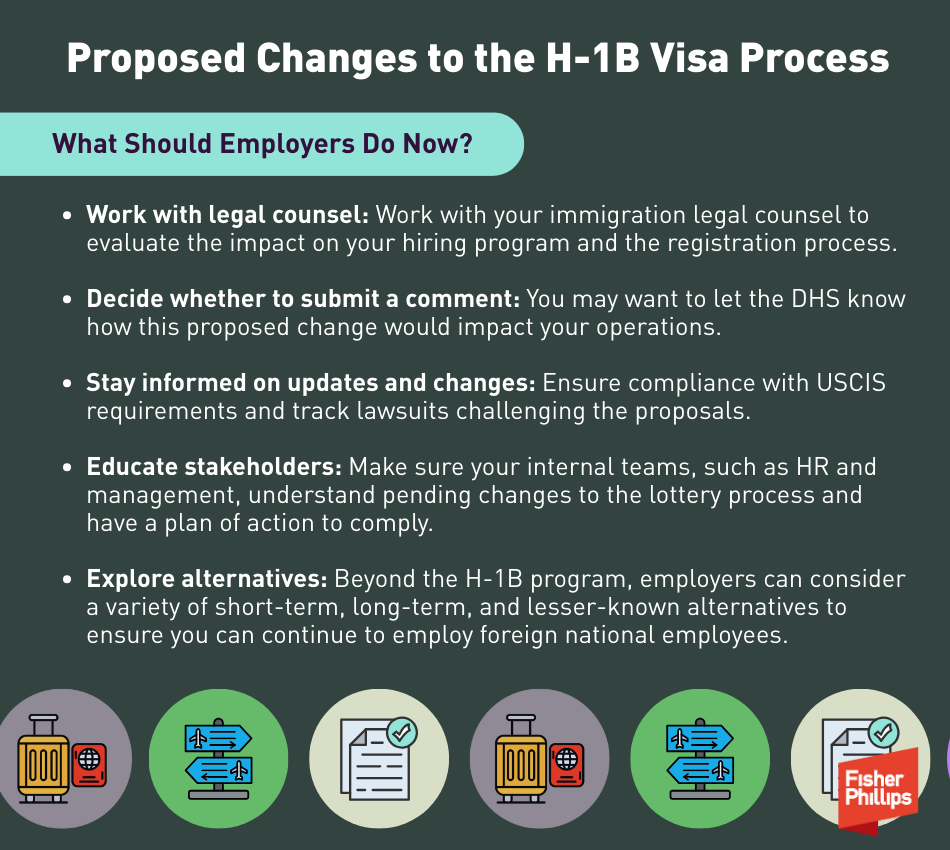Immigration Officials Propose New H-1B Selection Process Based on Wages: What Employers Need to Know
Insights
9.23.25
The Trump administration is making big changes to the H-1B visa program, and employers will need to quickly assess the impact on their operations. Late last week, the President announced a $100k fee for new H-1B applications, and just this morning, the administration proposed a rule to replace the random lottery system with a weighted, wage-based process for selecting recipients. The Department of Homeland Security (DHS) is aiming to “prioritize high-skilled, high-paid aliens in the H-1B lottery over those at lower wage levels,” according to a recent announcement. This is just a proposal, which needs to go through the formal rulemaking process, but we expect the administration to move quickly over the next few months to issue a final rule. What does this mean for your business, and what should you do to prepare?
[Ed. Note: DHS released the final rule on December 23, which you can read about here.]

Refresher on the Current System
- The H-1B visa program allows US employers to hire highly skilled foreign professionals.
- Each year, US Citizenship and Immigration Services (USCIS) allocates a limited number of H-1B visas. There are 65,000 slots available for "regular" H-1B registrations, with an additional 20,000 slots allocated to individuals with a US master's degree or higher.
- To apply for a particular year, employers must submit an electronic registration for each candidate they sponsor. If the number of registrations exceeds the quota, USCIS will conduct a random lottery process to determine which registrations will advance to the next stage.
- Over the past 15 years, the lottery has been necessary due to high demand by US employers.
Proposed Changes
- The Trump administration wants to replace the random lottery with a weighted system that prioritizes higher paying jobs but still allows H-1B visas to be awarded at various wage levels.
- The proposal identifies four wage bands, and petitioners in higher wage bands would be given more chances in the random selection process.
- The categories are based on the Occupational Employment and Wage Statistics (OEWS) wage levels for the beneficiary’s occupation as follows:
- Level I would be entered into the selection pool one time.
- Level II would be entered into the selection pool two times.
- Level III would be entered into the selection pool three times.
- Level IV would be entered into the selection pool four times.
- Regardless of entries, each beneficiary would only be eligible one time through a random, computer-generated selection process.
- The wage-based system would operate in conjunction with the existing beneficiary-centric selection process. The beneficiary-focused initiative launched in 2024 to combat fraud. It was designed to prevent multiple registrations for the same individual by different employers to ensure a fair and transparent system for all participants.
What’s Next?
- The new weighted selection process is just a proposal at this point. The next step is a notice-and-comment period during which interested parties can review the proposal and provide their input about suggested changes. In this case, the comment period will be open for 60 days upon publication in the Federal Register on September 24.
- Once the comment period closes, the agency is required to take each comment into account and then determine whether to adjust the proposed rule before it becomes final.
- We expect to see business groups and others challenge this proposed rule, as well as the $100k H-1B visa fee that the administration announced last Friday and took effect on September 21. You can read our answers to key Frequently Asked Questions about the new fee here.
What Should Employers Do Now?
- Work with legal counsel: Work with your immigration legal counsel to evaluate the impact on your hiring program and the registration process.
- Decide whether to submit a comment: You may want to let the DHS know how this proposed change would impact your operations. Your immigration attorney can help you with this process.
- Stay informed on updates and changes: Ensure compliance with USCIS requirements and track lawsuits challenging the proposals, as well as any additional new rules and regulations.
- Educate stakeholders: Make sure your internal teams, such as HR and management, understand pending changes to the lottery process and have a plan of action to comply if the proposal is finalized and ultimately takes effect.
- Explore alternatives: Beyond the H-1B program, employers can consider a variety of short-term, long-term, and lesser-known alternatives to ensure you can continue to employ foreign national employees. Here are 11 alternatives your organization can use to retain top talent and critical staff.

Conclusion
Fisher Phillips will continue to monitor the proposal and will provide additional updates as new information becomes available. In the meantime, we encourage you to sign up for Fisher Phillips’ Insight System to receive the latest updates. If you have any further questions, please contact your Fisher Phillips attorney, the authors of this insight, or any attorney in our Immigration Practice Group.
Related People
-
- Jocelyn Campanaro
- Partner
-
- Shanon R. Stevenson
- Partner

